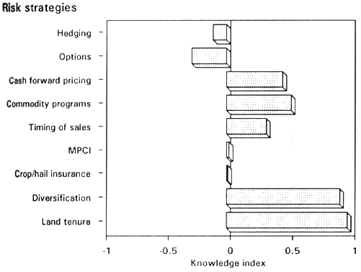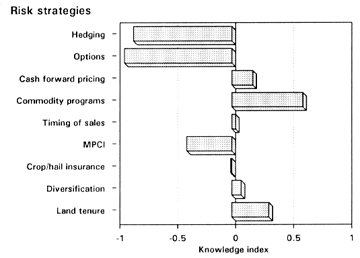Spring 1992 // Volume 30 // Number 1 // Feature Articles // 1FEA7
Risk Management Education
Abstract
This study demonstrated that agents are comfortable with many of the basic strategies farmers use for risk management. However, agents feel the least qualified to offer educational programs on the future markets and crop insurance. Both of these strategies should become more important as recent changes in U.S. agricultural policy, such as the move to flexible base in the 1990 Farm Bill, increase the risk for crop farmers.
The National Extension Initiatives emphasize efforts to increase profitability in U.S. agriculture. A component of "increasing profitability" involves efforts to protect profits from dropping to unacceptable levels. Even before the National Extension Initiatives, educational programs to help farmers make farm management decisions were increasing in importance. In part, this is because farmers have become more sophisticated managers relying more on various risk management strategies. In many cases, the choice and use of these risk management strategies are keys to farm survival.
Given these concerns, a national survey was done to learn more about risk management education of county agricultural Extension agents. A nationwide survey of agents was conducted to determine county agents' views about farmers' understanding of different risk management strategies and to determine how agents differ in their knowledge and use of educational programming about risk management strategies.
Survey Procedures
A phone survey method was chosen due to its relative ease in administration, insensitivity to geographical dispersion of the respondents, and potential for a high response rate.1 The Census of Agriculture was used to create a sample of 1,100 counties which were in the top half of all U.S. counties in total crop acres; in terms of market value of all crops sold; and in corn, wheat, and soybean production. The 1,100 counties represent at least 90% of the total U.S. crop value.
This selection process focused the survey on crop production counties where risk management strategies would be most needed. Of the 1,100 counties selected, 500 were randomly drawn from the survey. The sampling frame of nearly 46% (500 of 1,100 counties) is highly representative of the views of county agents in the top crop counties, but may not be representative of all agricultural agents in the nation.
The Survey Research Center at the University of Kentucky conducted the survey. Of 504 agent contacts, 468 were completed, resulting in a response rate of 93%. The phone surveyor asked to speak to the Extension agent whose area of expertise was in crops. A screening question required agents to have at least three years of work experience in the county, thus ensuring the respondents were familiar with the local situation. Of the 468 agents surveyed, 93% had a farm background, 75% had a graduate degree, and 66% had a degree in agronomy, animal sciences, or agricultural education.
The survey focused on nine risk management strategies: hedging using the futures markets; price options on commodity futures contracts; cash forward contracting; government commodity programs; timing of sales from storage; multiple peril crop insurance (MPCI);2 crop, hail, and fire insurance; diversification to reduce risk; and alternative land tenure arrangements.
Questions about the agents' knowledge of risk management strategies were scaled with five degrees of comfort. For example, agents were asked to "please give me a number from 1 to 5, where 1 means you have 'no knowledge' and 5 means you have a 'complete working knowledge.' " To summarize the results and provide a comparison between strategies, the responses were scaled down by a constant value of 3. Then an average was taken for each strategy after the questions were rated on a -2 to +2 scale where -2 corresponded to the "no knowledge" response and +2 to the "complete working knowledge" response. This was done to emphasize the neutral position, which was assigned a zero.
Results
The first group of questions assessed the county agents' knowledge of the nine risk management strategies and their perceptions of farmers' knowledge. Not surprisingly, agents generally believed they were more knowledgeable than the farmers in their counties. Using the average response for each strategy, Figure 1 shows county agents felt they had the most knowledge about diversification, alternative land tenure arrangements, cash forwarding, commodity programs, and timing of sales. They indicated less knowledge of hedging and options. Most felt they understood the concept of MPCI, but didn't understand it in depth.

Figure 1. Agent knowledge of risk management strategies.
When agents rated the knowledge farmers had about the risk management strategies, the same directional patterns emerged (Figure 2). The agents felt farmers understood commodity programs and alternative land tenure the best. They didn't feel comfortable about farmers knowledge of MPCI.

Figure 2. Farmer knowledge of risk management strategies.
Figure 3 indicates those risk management strategies agents felt should receive more educational emphasis. The four that ranked highest in terms of need were hedging, options, timing of sales, and diversification. The ratings indicate agents believed diversification needs more emphasis than MPCI, even though they also indicated farmers were more knowledgeable about diversification than MPCI. This may reflect the relative importance agents place on diversification.

Figure 3. Need for education of risk management strategies.
County agents were also questioned on the relative effectiveness of methods for delivering risk management strategies. Agents felt the most effective delivery method was one-on-one contact between Extension agent and farmer. Three other methods they felt were effective were informal interactions between farmers, teaching or conducting county producer meetings, and use of state specialists. In contrast, most felt that news articles, TV, radio, and other media programs weren't effective delivery methods.
When agents were asked if they felt qualified to teach the nine risk management strategies, the responses ranged from 26% who said they felt qualified to teach MPCI to 88% who felt qualified to teach diversification. Table 1 shows the percent of agents who have attended, taught, or provided risk management training in the past three years and the percent of agents who feel qualified to teach the risk management strategies. The focus of comments is on agents conducting county producer meetings or setting up meetings for teaching by Extension and research specialists. Eighty percent of the agents had conducted or provided some form of risk management education in the past three years. The percent of agents who had conducted or provided training ranged from 19% for crop, hail, and fire insurance to 66% for diversification.
| Table 1: Agent survey responses to risk management training. | |||
|---|---|---|---|
| Risk management eduaction programs | Conducted or provided | Attended | Qualified to teach |
| Diversification to reduce risk | 66.0% | 62.4% | 88.0% |
| Alternative land tenure arrangements | 46.6 | 43.4 | 76.3 |
| Timing of sales | 48.7 | 41.2 | 67.3 |
| Cash forward contracting | 59.4 | 53.0 | 62.6 |
| Government commodity programs | 63.5 | 64.2 | 56.6 |
| Hedging using futures markets | 59.0 | 63.5 | 39.7 |
| Price options using futures contracts | 58.1 | 65.4 | 34.0 |
| Crop, hail, and fire insurance | 19.4 | 23.1 | 28.4 |
| Multiple peril crop insurance (MPCI) | 21.2 | 27.4 | 25.6 |
In addition, 84% of the agents had attended some form of risk management training in the past three years. The range in the percent of agents who had attended is similar to that found in the statistics for conducting programs on risk management strategies. In other research designed to predict the probability that an agent had conducted training on a specific strategy, the training the agent received in that strategy was the most consistent explanatory variable.3 This demonstrates the importance of agent training in influencing agent programs.
Strengthening Risk Management Education
This study demonstrated that agents are comfortable with many of the basic strategies farmers use for risk management. However, agents feel the least qualified to offer educational programs on the futures markets and crop insurance. Both of these strategies should become more important as recent changes in U.S. agricultural policy, such as the move to flexible base in the 1990 Farm Bill, increase the risk for crop farmers.
Only one out of four felt comfortable teaching MPCI. Although 27% of the agents had attended MPCI training in the past three years, most still didn't feel qualified to teach the subject. This was particularly true in the southern region of the country. This finding indicates educational efforts on MPCI need to be more intensive or more frequent. Further education may enhance the agents' view that MPCI is an effective risk management option and encourage them to convey this attitude to farmers. These conclusions support agent beliefs that the best way to increase MPCI participation is to increase farmer education on overall risk, risk management, and MPCI.
The survey also indicated a strong need for educational emphasis on hedging and options. These strategies were rated as the least understood by agents and farmers. This means more agent training is needed on on these strategies before agents can teach them. A need for educational emphasis on diversification was also indicated, even though agents feel they understand diversification. This means that agents can teach farmers about diversification without much additional training.
Conclusions
With limited funding and Extension personnel, which educational programs should be targeted for increased emphasis to support National Initiatives? In the case of agricultural profitability, answering this question requires a thorough understanding of how farmers perceive risk and their reasons for making certain farm-level decisions. It also requires an understanding of how information flows among farmers, Extension agents, and Extension and research specialists. The survey focused on differences in agents' knowledge and their perceptions of farmers' knowledge of risk management strategies. Future Extension educational efforts should focus on strategies farmers are requesting most frequently and what part the farmer's risk preferences and level of knowledge of risk management strategies have in the overall picture.
Surveys such as this can be used by Extension personnel to identify gaps in knowledge and agent training needs in particular counties. This process has broad application to other initiatives and Extension subjects. The survey instrument can be a strong tool for efficiently directing funds to those areas that most need educational emphasis.
Footnotes
1. Don A. Dillman, Mail and Telephone Surveys: The Total Design Method (New York: John Wiley and Sons, 1978).
2. Multiple peril crop insurance (MPCI) refers to federally subsidized insurance supported by the Federal Crop Insurance Corporation and marketed through private reinsurance companies.
3. Fred J. Benson, Jean C. Buzby, and Jerry R. Skees, Explaining Differences Among County Extension Agents' Knowledge and Attitudes About Risk Management Strategies (Lexington: University of Kentucky, Department of Agricultural Economics, Staff Paper #310, October 1991).
